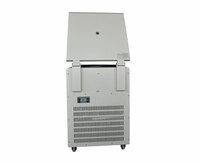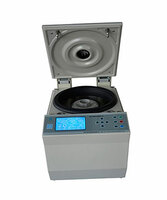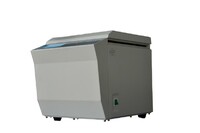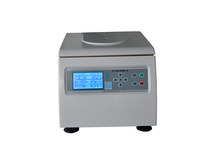LOW SPEED CENTRIFUGE
Specifications
The low-speed centrifuge is widely used for separating lab solutions and particles. Popular in places like hospital blood banks and blood processing centres, it is ideal for analyzing biological
samples. The low-speed centrifuge is adaptable to various rotor configurations such as a winging bucket. The structure design of the low-speed centrifuge is reasonable, which effectively eliminates
the sanitary dead angle. The transition of the structural parts is smooth, and the surface is polished. The external structural parts, fasteners, and drums are made of stainless steel. The digital
display on it shows the centrifuging time, rotation speed, and centrifugal force.
Characteristics of Low Speed Centrifuge
Low speed centrifuge is widely applicable. In addition to the separation of granular suspensions, it can also be used for separating fibrous materials.
With sprinkler system responsible for the cleaning of centrifuge shell, inner wall, liquid collecting tank, and other visible parts, the cleanliness is ensured.
Low speed centrifuge is of simple and compact structure, easy to operate and maintain.
Adopting microcomputer control with digital display, the machine is driven by AC/DC frequency conversion motor.
Electric door lock automatically locks once the motor is started to ensure safe running.
Difference between Low Speed and High Speed Centrifuge
Even without a specific definition, it is apparent that speed is the main difference between the two types. Normally, the maximum speed of low-speed centrifuge is 4000-5000 rpm, while the speed of
high-speed centrifuge can be over 15000 rpm. Unlike the low-speed centrifuge, which is operated at room temperatures, the temperature of high speed centrifuge can be carefully controlled. In terms
of the scope of application, the low speed centrifuge deals with the routine sedimentation of particles, and more sophisticated biochemical tasks are handled by high speed centrifuge.
How to Operate a Low Speed Centrifuge?
1. Lift the cover and put the centrifuge tube into the rotor.
2. Tighten the screw on the rotor and check the sample is placed symmetrically.
3. Lock the cover, plugin, turn on the power switch.
4. Set the rotor number, time, speed, centrifuge force.
5. When the rotor stops, press the red button, open the cover and take out the centrifugal tube.
6. Turn off the power switch of the low speed centrifuge.
Contact us for a specific low speed centrifuge diagram and the operating video.
Low Speed Centrifuge Application
Low-speed centrifuges can be widely used in clinical medicine, biochemistry, immunology, blood stations, and other fields. They are ideal equipment used in the laboratory for centrifugal
precipitation of conventional instruments.
If you want to know the details of low speed centrifuge definition and low speed centrifuge uses, contact us.
There are many laboratory equipment manufacturers, but we are one of the best choices for you.
- Country: China (Mainland)
- Business Type: Manufacturer
- Market: Africa,Americas,Asia,Emerging Markets,Europe,Middle East
- Founded Year: 1995
- Address: No 666 Innovation Avenue, High-tech zone, Hefei, Anhui, China
- Contact: zonkia-medical .com










